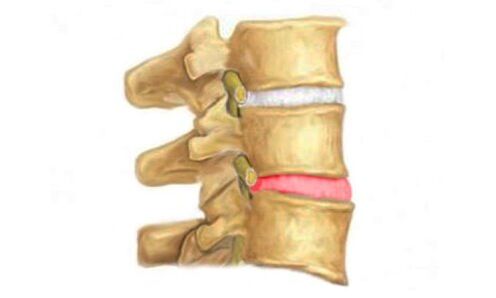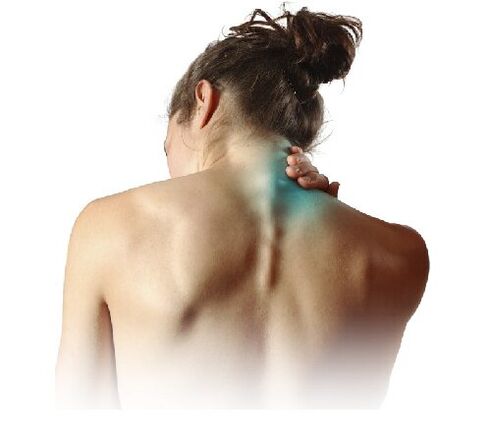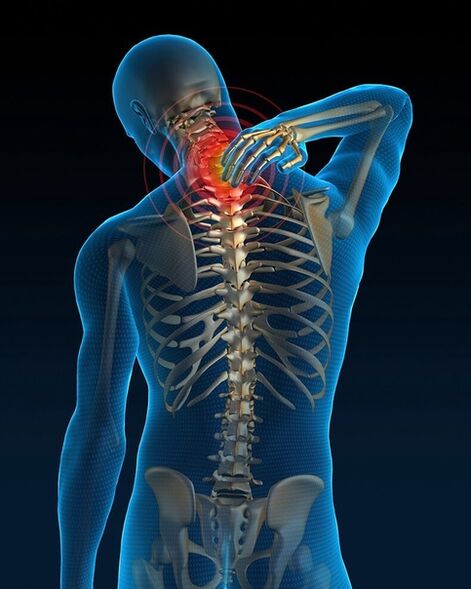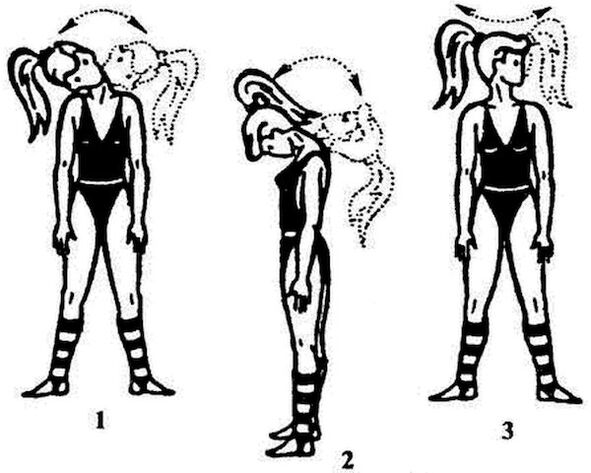
Osteochondrosis of the cervical spine is a disease of the spine, which is characterized by degeneration of the intervertebral disc, with the presence of a significant decrease in its height, reactive growth of the marginal osteophyte, as well as sclerosis of the intervertebral discs.
The vertebrae of the cervical region are close enough to each other. The muscular framework in this area has a relatively weak development, therefore, cervical osteochondrosis, even in the case of a light load, leads to a displacement of the spinal disc, followed by compression of the nerves and blood vessels.
The affected cartilaginous tissue of the disc due to osteochondrosis gradually turns and degenerates into a bone formation. As a result, the disc hardens and decreases in size, eventually losing the cushioning properties between the vertebral discs, which causes pressure on the nerve endings, with the additional appearance of pain.
The intervertebral discs of the cervical region are a fibrocartilaginous plate. In the middle of the disc is the nucleus, which is surrounded by an annulus fibrosus, that is, a tissue that resembles tendons. The intervertebral disc does not have a vascular system, and therefore nutrition occurs with the help of other tissues.
An important source of intervertebral discs are spinal muscles, it is their dystrophy that leads to symptoms of osteochondrosis.. In the process of lifting weights, jumping or other physical exertion, the shock-absorbing functions of the spine maintain the necessary distance between the vertebrae. The disorder is a pathology. Photo below.

I would like to emphasize, since bulges (the main signs of osteochondrosis) are much more likely to form in the lumbar spine, and therefore complications appear - intervertebral hernias.
An intervertebral disc bulge is a prolapse (protrusion) of the disc without rupture of the annulus fibrosus.
The outflow of the nucleus pulposus, that is, the rupture of the fibrous ring, is a herniated disc - the final stage of osteochondrosis.
Reasons for development
- infections.
- Poisoning.
- metabolic disease.
- Age changes.
- genetic predisposition.
- Lack of fluids and vitamins in the diet (malnutrition).
- Spinal injury.
- Over weight.
- Bad ecology.
- Posture disorder.
- Rachiocampsis.
- Flatfoot.
- A sedentary way of life of the body.
- Instability of segments in the spine.
- Prolonged stay in uncomfortable positions (pressure on the discs).
- Frequent jerking movements or changes in body position.
- Spinal overload from wearing uncomfortable shoes, such as high heels.
- Physical exercise.
- Unevenly developed musculoskeletal system.
- The pregnancy.
- stressful situations.
- Excessive alcohol consumption.
- Of smoking.
- Hypothermia.
- Staying in a cold environment for a long time.
- Nervous tension.
Signs and symptoms
Osteochondrosis of the cervical spine has the following symptoms:
- dizziness, headache. It is noteworthy that in most cases the signs of cervical osteochondrosis are accompanied by headaches. This circumstance is associated with pressure on the vessels of the cervix and head. Usually these symptoms and pain syndrome cause a person serious discomfort, which reduces performance. Also, the headache is intensified by various movements of the body;
- dizzinessappear during a sharp turn of the head to the side;
- Chest and arm painduring the period of osteochondrosis of the cervical region, it is very similar to the signs of angina pectoris, that is, burning or oppressive pain in the heart. In most cases, pain in the hands is accompanied by a tingling sensation and numbness;
- Lumbago- This is the most common symptom of cervical osteochondrosis. An unpleasant sensation similar to a strong pain spreads to the fingers of the hands;
- numbness of the tongue. The appearance of this symptom of cervical osteochondrosis causes a restriction of tongue movements. In this regard, many patients complain of a change in the tone of the vocal cords (they become very rough), as well as speech.

Diagnosis
Therefore, diagnosis and treatment is carried out by medical specialists: vertebrologists, orthopedists, neurosurgeons, with the help of a visual examination of the patient in connection with complaints of limited mobility or deformity. Examine the patient sitting, lying down, standing, at rest, or in motion. The level of damage in the spinal area is determined according to a special scheme.
Determination of the localization, degree and nature of pain, increased tension in the muscles along the spine is carried out by feeling the spine. Bending, twisting, bending the body indicate the range of motion in the affected area.
In the future, osteochondrosis is diagnosed using magnetic resonance imaging, computed tomography or radiography. Checking the state of the vessels of the cervical region requires the appointment of duplex ultrasound or ultrasound tomography.
Treatment

Osteochondrosis of the cervical spine and its complications are treated with conservative methods that are aimed at eliminating pain syndromes, dysfunction of the spinal roots, and preventing the progression of dystrophic changes in the structure of the spine. In the event that conservative treatment is ineffective, then, according to certain indications, surgical (operative) treatment is carried out, where the volume depends on the clinical manifestation of osteochondrosis and the level of the lesion.
The treatment of osteochondrosis directly depends on the severity of the course of the disease, age-related changes, the method of treatment used, the conscientious implementation of the recommendations and prescriptions of the attending physician.. Usually, at the beginning of treatment, there is an increase in pain in the cervical spine, but it soon stops with the use of medications, physiotherapy procedures, as well as with the performance of physical procedures and therapeutic massage.
The most effective result in the treatment of osteochondrosis is the complex treatment of diseases of the musculoskeletal system as a whole.
Training
Exercises and gymnastics for osteochondrosis in the cervical spine help reduce pain, strengthen the cervical muscles, so that osteochondrosis reduces the likelihood of relapse.
- It is recommended to start witha simple exercise: ten sharp turns of the cervical spine. Gymnastics is performed as follows: the head is turned in one direction, while freezing at a certain point for several seconds, then at the other, repeating the procedure. During the exercise, the head should not be lowered, the gaze is directed in front of you.
- Exercises - head tilts. The head is tilted to the left to touch the shoulder joint with the ear, and the shoulders should be kept relaxed. We repeat on the right side. The above exercises restore the shock absorption properties. Photo below.
- Stretching exercises for the neck muscles.We bend our necks and tilt our heads back and forth. In the process of moving forward, the chin is pressed against the chest and is held in a similar position for several seconds. As a result, we screw the head back to its original position and tilt it back. The exercises are repeated ten times.

As you can see, exercises or gymnastics for the neck are very simple, but tremendously effective. The main thing is to exercise regularly..
Massage
Osteochondrosis is not a sentence! Drug treatment, massage and therapeutic exercises are quite possible at home.
Massage of the cervical spine with osteochondrosis is carried out in the presence of a person close to you. Massage oil is used to reduce discomfort.
To perform the procedure, the neck is prepared, so the patient is placed on a wide surface, and a folded towel is placed under the shoulder blades. These actions will help stretch your neck muscles and lengthen your spine. For some time, the patient's muscles relax. As a result, the patient sits in a chair with a straight back..
After a certain time, the neck is lubricated with massage oil. The oil takes into account drugs that have the effect of relieving headaches. This oil usually contains capsaicin, which warms up when used, thus providing a comfortable environment at the time the massage is performed.
So, the massage begins as follows, the trapezius muscle, which descends from the upper part of the neck to the shoulder, is groped. Knead hard enough to feel the pressure, but gently, without pain. The muscle on the left side is massaged with the right hand. Each muscle is counted for five minutes, then rested and repeated again.
The massage is completed by wrapping the massaged place with a warm towel, after which bed rest is desirable.. Proper massage exercise causes drowsiness.
























